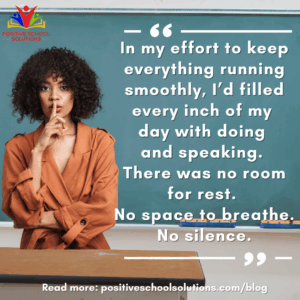I used to believe that every second of teaching had to be filled—with words, activity, energy.
used to believe that every second of teaching had to be filled—with words, activity, energy.
I’d ask a question and immediately call on someone. A student would answer and I’d repeat it for the class. I’d give directions and then re-explain them five different ways just to be safe.
I was constantly talking—because I thought that meant I was constantly teaching. But it wasn’t sustainable.
Time always felt tight. Every moment felt like a race.
🕘 Can I squeeze in two more minutes of silent reading?
🕘 Can I stretch this math lesson just long enough to finish one more problem?
🕘 Can I rush us down the hall so we’re only one minute late instead of three?
🕘 Dismissal in 25 minutes—can I cram this entire 30-minute lesson in and still have students ready for the bus?
I didn’t realize it at the time, but I was equating noise with learning.
And in doing that, I was missing something really important.
The Turning Point
A few years ago, I watched some of the most talented teachers I knew begin to lose their spark. Their passion for teaching was overshadowed by stress—and it was impacting everything, both inside and outside the classroom. I couldn’t ignore the signs of burnout.
I recognized it because I’d felt it too.
In my effort to keep everything running smoothly, I’d filled every inch of my day with doing and speaking. There was no room for rest. No space to breathe. No silence.
But here’s what I eventually learned:
Silence isn’t the absence of teaching—it’s the space where learning can actually take root.
Why Silence Matters
Think about a moment when you were really feeling something—disappointment, frustration, even pride. Chances are, silence was part of that experience.
Now think about a time when something really clicked for you—a lesson you learned deeply. Maybe it came after quietly rereading a passage. Or mentally walking through a project you finally nailed. Or maybe it was the stillness after a conversation that helped you understand what really needed to happen next.
Reflection doesn’t happen in the rush.
It happens in the pause.
And I realized that the same was true for my students.
What I Noticed When I Let Silence In
At first, I used silence only when I was upset.
You’ve probably done it too—when something goes off the rails and you stop talking, everyone knows something is up.
But what if we didn’t save silence just for those moments?
What if we:
- Asked a question, then actually waited 10 full seconds before calling on anyone?
- Gave directions, then said: “Let’s take 15 seconds to plan our moves in silence before we begin.”
- Let a student share an idea, and instead of responding right away, we paused for two beats to let it land?
- Showed a slide with instructions and didn’t repeat ourselves, allowing students to re-read, reflect, and ask thoughtful questions?
The more I used silence with intention, the more I noticed changes. Not just in my own energy—but in my students, too.
They were more thoughtful.
They listened to each other more.
They stopped relying on me to rephrase everything.
And surprisingly… I started gaining time back.
If you repeat 10 student answers a day and each takes 30 seconds, that’s 5 minutes. Every day. Just from repeating what students already said.
What could you do with five extra minutes?
Try These Silent Shifts
Here are a few easy ways to start building silence into your classroom—in ways that support both behavior and learning:
- Wait Time Challenge
Let students know: “I’ll ask a question, and then wait 10 seconds before calling on anyone.” Then hold yourself to it—look at your notes, the ceiling, anything but hands raised. Wait it out. - Silent Slide Directions
Share bulleted steps on the board. Say them once, then tell students:
“Read over these silently. I’ll take questions in 15 seconds.”
It reduces repetition and helps students take ownership. - “Build On That” Strategy
When a student answers, skip the repeat. Nod, pause, and ask:
“Who can build on what they said?”
This shifts the dynamic—students start listening to each other. - Silent Start Warm-Up
Begin class with one quiet, thoughtful prompt on the board. Let students enter and reflect silently for one minute. It changes the tone of the whole day. - Non-Verbal Transitions
Try silent countdowns or hand signals for transitions instead of over-explaining. Less noise, more flow.
What I Know Now
Silence used to make me uncomfortable.
But now I see it as a signal—of trust, reflection, and respect.
It tells students: You have time to think. Your words matter. We don’t have to rush.
If I could go back and tell my younger teacher self one thing, it would be this:
You don’t have to fill every moment to make it meaningful.
Sometimes the most powerful teaching happens…
when you just let the room be quiet.
Want more simple shifts that boost engagement and save you time?
Check out our on-demand course: Maximizing On-Task Behavior—packed with ready-to-use strategies you can implement tomorrow.
Writen by Sarah Fillion 2025

